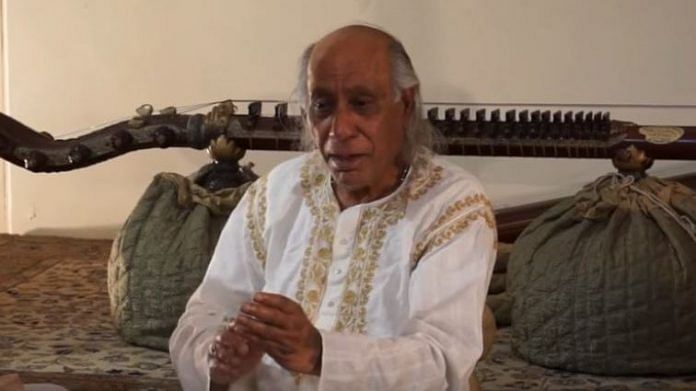New Delhi: If you trawled YouTube for footage or an audio recording of a 1970s United Nations concert where Ustad Zia Fariduddin Dagar, the celebrated classical vocalist, performed the Raag Bhairavi with his brother Ustad Zia Mohiuddin Dagar, it’s unlikely you would find it.
The sound recordists at the venue were so mesmerised by the performance, Fariduddin’s nephew Ustad Baha’uddin Dagar says, that they forgot to hit record.
But that was just par for the course for Ustad Zia Fariduddin Dagar, a titan of the Hindustani classical tradition of Dhrupad whose mastery of his art won him an army of fans all over the world.
Together with his brother, Fariduddin represented the 19th generation of Dhrupad musicians in the family.
As the world marks his sixth death anniversary, ThePrint looks back at the life of a classical musician who took his craft across borders and seas.
Also read: Bade Ghulam Ali Khan, the ‘Tansen’ who demanded & got Rs 25,000 per song for Mughal-e-Azam
A family tradition
The Dhrupad tradition is believed to be the oldest form of Hindustani classical music, with origins in the 11th century.
Since then, this tradition has gradually evolved while maintaining its defining focus on retaining the purity of the raagas.
Through the ages, Dhrupad exponents regaled royal courts and emperors, but its popularity faded as the command of kingdoms diminished towards the 20th century, and other schools of music, like Thumri and Khayal, gained prominence.
The credit for its revival goes majorly to the Dagar clan.
Fariduddin was born on 15 June 1932 at Udaipur, Rajasthan. His father Ustad Ziauddin Dagar was a court musician to the Maharaja of the city, which had been a family tradition.
Fariduddin was trained in Dhrupad by his father and elder brother Mohiuddin, a doyen of the rudra veena, and often performed with the latter. The duo came to be known as “Chhote Ustad [Fariduddin]” and “Bade Ustad [Mohiuddin]”.
In his long career as a performer and a guru, Fariduddin has been honoured with several national awards, including the Sangeet Natak Akademi Award (1994). He also received the Rajasthan Sangeet Natak Akademi Award (1987) and the Tansen Samman (1993) of Madhya Pradesh, where he worked as a music teacher in the 1980s.
Performer and guru
Not much has been documented about Chhote Ustad’s compositions, which he performed at several concerts, but those who had the opportunity to hear him remain enchanted by his nuanced singing.
“Ustadsaheb sang the traditional compositions, he would even like to modify some… He would sometimes recompose some of the old compositions that he thought were suited in a different raaga,” his nephew and renowned rudra veena player Ustad Baha’uddin Dagar told ThePrint over email.
“At the same time, the raagdari and the purity of the gayaki of our gharana was beautifully maintained,” he added.
“There was a fearlessness in his execution of raagas. He would make a raaga stand very close to many other raagas, and this was an extremely difficult feat… as a single slip would mean one has entered another realm of raagas,” Baha’uddin said.
Pandit Uday Bhawalkar, one of Chhote Ustad’s most famous disciples and a highly-respected Dhrupad vocalist in his own right, described his singing style as “imaginative”.
“He was very imaginative as there were many surprise elements in his singing,” he said to ThePrint. “He would also sometimes create phrases that one would normally not use in a raaga but he would use it in such a way that would make it sound very beautiful.”
However, Baha’uddin said that Fariduddin became a darling of the West long before he gained a considerable fan following in India, with the advent of the ‘Hippie era’ in the 1960s and the 1970s awakening the US and Europe to the depths of Indian classical music.
Bhawalkar said this was a time when many westerners were swooning over Indian classical music, courtesy legendary sitarist Pandit Ravi Shankar, who was a frequent performer in the West.
“Chhote Ustad’s audiences were very limited here (India). But in Europe and other western countries, people loved his voice and his wildness if I may say so in his music,” Baha’uddin said.
Bhawalkar added that Fariduddin’s biggest contribution to music remained keeping the Dhrupad tradition alive.
A teacher of ‘immense patience’
At one point, Chhote Ustad was on the verge of moving to Europe, from where he had received some teaching offers. However, noted poet Ashok Vajpeyi, who was then serving as secretary in the Madhya Pradesh Department of Culture, convinced him to stay back by setting up a Dhrupad centre under Ustad Allauddin Khan Music Academy, Bhopal, in 1981.
Chhote Ustad then completely immersed himself into active teaching, going on to train such stalwarts as Bhawalkar, the Gundecha brothers, Baha’uddin. Dhrupad maestro Pandit Ritwik Sanyal was also tutored by Chhote Ustad along with his brother Bade Ustad.
While Baha’uddin hailed him as a “remarkable teacher”, Bhawalkar recalled how he would make pupils wake up at 4 am and perform “riyaaz” for up to eight hours a day.
Another of his pupils, Kiran Seth, an academic and founder of Spic Macay, an organisation involved in the promotion of Indian classical music and art heritage, hailed his “infinite patience” in a 2013 interview with The Hindu.
Also read: Pandit Ravi Shankar — the sitar maestro who introduced ragas to the West
An earlier version of the article said Ustad Zia Fariduddin Dagar and his brother Ustad Zia Mohiuddin Dagar represented the 14th generation of Dhrupad musicians in the Dagar clan. They actually represented the 19th generation.



